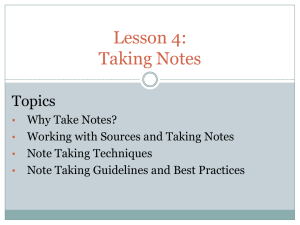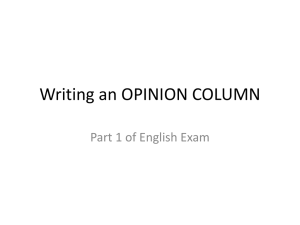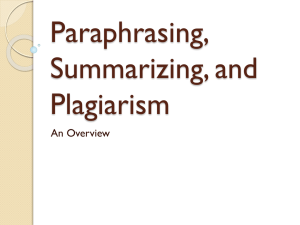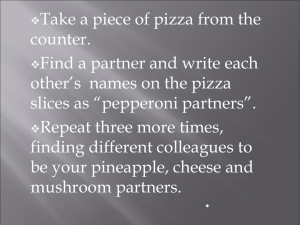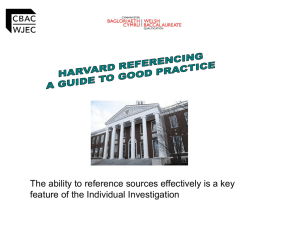PMAB Training: Aggression Management & De-escalation Techniques
advertisement
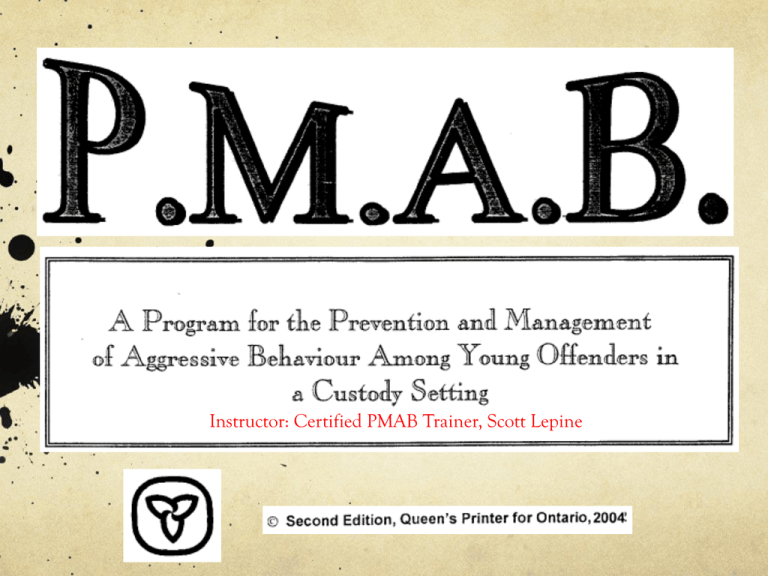
Instructor: Certified PMAB Trainer, Scott Lepine What is PMAB? Cognitive Behavioral Theory C.B.T. Cognitive Thinking Errors 1. POWER THRUSTING (“My way or the highway”) 2. FALSE VIEW OF SELF (“I’m the best”) 3. UNREALISTIC EXPECTATIONS (“Good things will come my way”) 4. LACK OF PERSPECTIVE TAKING (“I’m the only one who counts”) 5. VICTIM STANCE (“Blaming”) 6. JUMPING TO CONCLUSIONS (“I wasn’t thinking”) 7. FAILURE TO BE STRAIGHT (“Liar liar!”) 8. AWFULIZING (“It’s all over!”) Predisposing/Precipitating Factors of Aggression Summary Communication During the Aggression Cycle THE CYCLE OF AGGRESSION Physiological PRE-CRISIS PHASE RATIONALITY Increased heart rate, blood pressure, lung capacity and metabolism Gastrointestinal changes Behavioural Low level agitation / muttering to staff / more active Clenched fists, staring, tensing of body Suddenly outgoing or quiet Psychological Listens and responds to direction Reasoning capacity remains CRISIS PHASE: IRRATIONALITY Physiological Maximum heart rate, blood pressure, lung capacity. Metabolism and physical strength Gastrointestinal changes Behavioural High level agitation, shouting, swearing, punching, kicking Dangerous to self and others Psychological Will not listen or respond to direction No reasoning capacity angry POST-CRISIS PHASE: RATIONALITY Physiological heart rate, blood pressure, lung capacity, metabolism and physical strength return to normal state. Gastrointestinal functions return to normal. Behavioural Level of agitation slowly recedes Body relaxes, high levels of tiredness/crying Talkative or reclusive Remorseful or defiant Psychological Reasoning capacity returns Willing to listen Respond to direction NOTE: Aggressive acts never happen in isolation. They are always preceded and followed by observable and recognizable behavioural and psychological features. Everyone in close proximity to the aggressive act is directly affected. Just as the aggressor, behavioural, psychological and physiological changes occur in those involved. The physiological feature may nor be recognized by staff but affect the individual. The behavioural, psychological and physiological in each phase will directly influence the staff’s choice of effective management strategies and techniques. There are no differences where the pre-crisis finishes and the crisis begins. CONTINUE: Although the graphic suggest a continuity and predictability to the cycle, this is not the actual fact because the cycle can be compressed into a space of a few minutes or extended over the course of several days. The behavioural and psychological changes can be occurring hours or even days before an aggressive act occurs, but the physiological changes begin shortly before the crisis phase and can continue several hours after the post-crisis. During the crisis phase, the gradual build-up of such changes may not be a steady one. During the crisis phase, staff needs to physically intervene in order to protect the others. This risk of injury is greater during the crisis phase. KNOWLEDGE OF THE CYCLE PROVIDES INFORMATION ON WHEN/HOW/WHERE TO INTERVENE. THE PROGRESSION FROM ONE STAGE TO THE NEXT CAN BE PREVENTED! Calming and Diffusing Techniques Calming Techniques When to use: In pre-crisis when the resident is willing to listen and able to reason Purpose: To explore the situation To get resident to discuss the problem To reduce resident’s agitation Open Questions Listening Responses Paraphrases Stating Clear Expectations Disarm Power Struggles Timing Out Humour Distraction Planned Ignoring Reviewing Option, Choices and Outcomes Choices Options Information Positive Reinforcement Negotiate (Win/Win) Defusing Techniques When to use: In crisis phase before verbal behaviour becomes violent Crisis Phase Purpose: To de-escalate potentially violent situations without violence occurring Defusing Defusing Observation Physical Presence Light to Heavy What to Say Approach Preparation Summary The Art of Paraphrasing The Art of Paraphrasing Involves using fresh words to state back what the youth has just said. The focus is on the situation or ideas rather than on feelings. The Art of Paraphrasing Paraphrasing has two important purposes: First, it allows youths to know and feel that you are hearing them and that you want to try and understand. Second, it usually prompts youth to continue expressing more thoughts and feelings about their situation. Be careful not to overuse paraphrasing, because it will seem gimmicky, ingenuine, and may become annoying to the youth. The Art of Paraphrasing The Most Powerful Communication Tool Definition: Paraphrasing is a necessary backup system to communication. It means to put the other person’s MEANING into your WORDS and give it back. As a power tool it does 14 things to improve your communication power. The Art of Paraphrasing 1. You can INTERRUPT someone and not generate resistance. 2. You can take CONTROL of the encounter. 3. You ‘get it right’ on the spot. We don’t’ always hear well. 4. The other can CORRECT you if you have mad en error. Makes the other feel good, and is good for you. 5. It MAKES the other a better LISTENER. No one will listen harder than to his OWN point of view. 6. It CREATES EMPATHY. The other will believe you are trying to understand. The Art of Paraphrasing 7. It often MAKES the other MODIFY his or her initial statements (become more reasonable) because her or she gets to hear his or her MEANING in different WORDS and tones. 8. It overcomes SONIC INTENION. People often think they have said something to you because they have ‘heard’ themselves say it in their mind. When you paraphrase, they hear what you have heard, not what they THINK they have said. 9. It can CLARIFY for those who may be standing nearby. 10. It prevents METAPHRASE: the use of the ‘skewed phrase’. The good paraphraser will never ‘put words into the other’s mouth’ The Art of Paraphrasing 11. Whenever you GIVE directions to others, insist THEY paraphrase back to you your meaning, 8 out of 10 people misunderstand the POINT of a verbal exchange. Protects you as manager/supervisor. 12. Whenever YOU take direction, it ensures you heard and interpreted correctly the other’s MEANING, PARAPHRASE BACK. The other may not have even said what he or she intended. Covers you from making errors. Makes you EFFICIENT and EFFECTIVE. 13. It reinforces your own memory. The mind remembers what the mind DOES. Your reports, written or oral, will be more concise and accurate. 14. It generates ‘THE FAIR PLAY’ response. You have listened and made an effort to understand the other. The other is almost forced Physical Restraints & Legislative Expectations and Residential Child Care Experience Excited Delirium and Risk of Positional Asphyxia Excited Delirium and Positional Asphyxia Excited Delirium and Positional Asphyxia http://blutube.policeone.com/police-trainingvideos/935602325001-excited-delirium/ Written Theory Test GOOD LUCK! Scott.lepine@parnipcas.org
